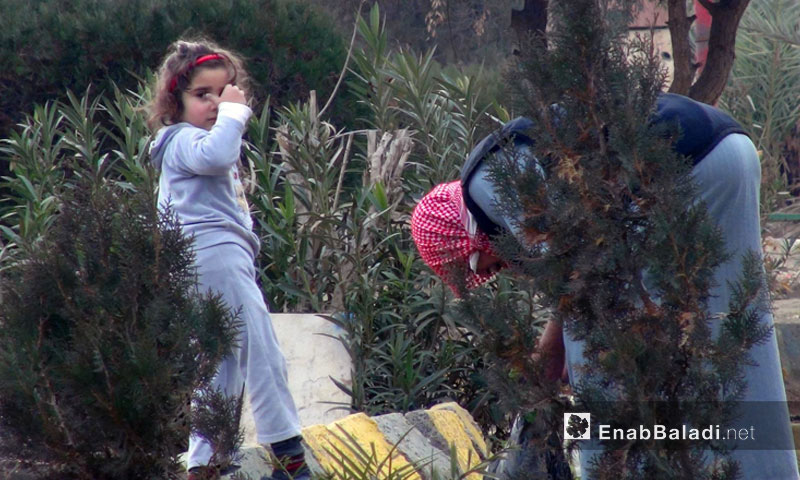



Abu Mohammad, 54 years old, turns the soil in his house’s garden over, the garden in which the soil has petrified, and the trees died, the garden from which life has departed, after he abandoned it for years.
“There was not enough water for people, so how could he water the plants,” Abu Mohammad tells Enab Baladi, leaning over the fence of his small garden in front of his house in the al-Kussur neighborhood. The garden means a lot to him, for it has incubated trees that are as old as his children, according to the way he described it, stressing that “I love Damask rose and jasmine, I will start growing them again.”
About his feeling upon touching the soil in his garden, the one that he abandoned for years, he says “it is beyond description,” adding that, “I will try to revive it with all the weak energy I possess.”
The rehabilitation and the renovation of the home gardens is a phenomenon that disappeared many years ago with the siege. Um Hussian, 43 years old woman, says that the water shortage, limited rainfall and logging have created a sense of negligence towards these gardens among people, in addition to the displacement of thousands of people from the area due to the continuance shelling back then.
The conflicts that the city have witnessed have turned the idea of gardening “into a luxury that no one could think of”, according to Um Hussian, pointing out that “the hungry and thirsty people would not think of gardening or flowers.”
However, with the slight changes in the area and the return of some of the people, the city started to recover gradually, according to Um Hussain, for the green spaces in the city, though small are standing out throughout the city’s streets, remembering her home’s garden in the al-Hawika neighborhood, “it contained citron, lindens, olive, fig and palm trees.”
Today, the woman is trying to rearrange its house, for not many things have been left of it after the destruction that befell its parts due to the mortar shells, “we have to tidy our lives up with the available resources, and to decorate the gardens even if a little.”
The gardens, scattered here and there in the city, play a tranquilizing role; they might be able to give a sense of peace to the “sad” city, filled with soldiers, security members and check points that inspire fear among the people, according to Um Hussain.
Mohammad, ten years old, from the al-Jowrah neighborhood, from where he never left since he was born, says that gardens make him happy, telling Enab Baladi that “they are beautiful, but they do not really appear among the rubble.’
The number of returnees to the city of Deir ez-Zor, especially employees, increased during the days following the regime’s control over the entire city, the last part of which was Hamidiyeh neighborhood, in early October 2017. The city, however, is still suffering water and electricity cuts.
The situation in parts of the city has improved partially despite the negligence, as it still lacks water and electricity, enduring a tight security grip of both Assad’s forces and local militias which interfere in the minute details of the people’s lives.
if you think the article contain wrong information or you have additional details Send Correction